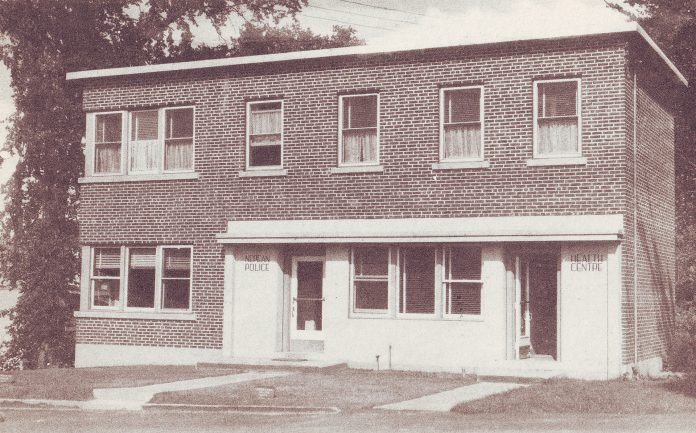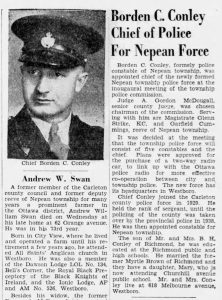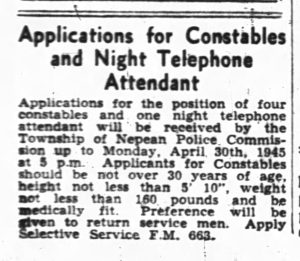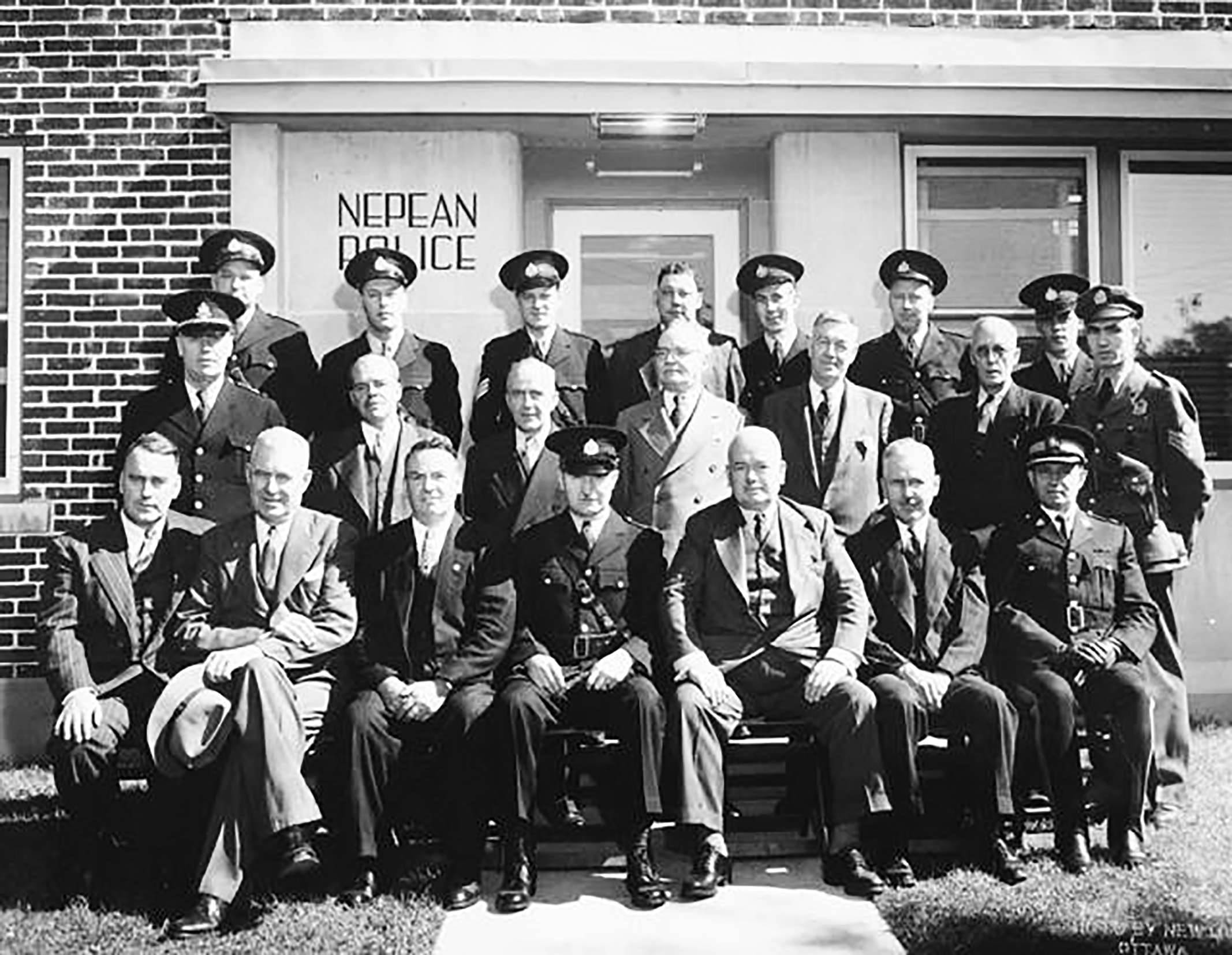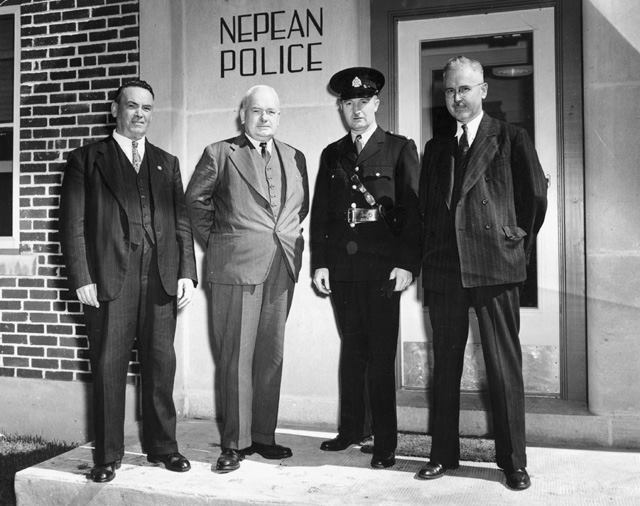By Dave Allston
Now a neighbourhood in central Ottawa, there was a time when Westboro Village was its own “police village.” The official status, attained in 1905, allowed for the village to establish its own council to direct spending on local priorities such as roadways, sidewalks, drainage, lighting, sanitation, fire protection, and policing.
You might be surprised to learn that Westboro had its own police station and jail cells until as recently as 1983!
In the earliest days, policing was done by Carleton County constables, who oversaw Nepean broadly. Criminals would be taken to the Carleton County Gaol on Nicholas Street (now the youth hostel).
When Westboro was expanding rapidly pre-WWI, the increase in collected taxes afforded it the ability to hire a dedicated constable, truant officer and sanitary inspector. In 1915, Jerry Cooke was appointed to this all-in-one role, given a uniform and revolver, and empowered to enforce Westboro’s laws (as he would for the next 15 years). Jail cells were briefly constructed in the basement of Nepean Town Hall on Richmond Road.
In 1929, a Carleton County police force was organized, mostly as a highway patrol. By 1938, the Ontario Provincial Police (OPP) took over, though a township constable (Borden Conley) was retained for bylaw enforcement, dog tax and fee collection and school truancy, and was still looked to as the local Westboro policeman. In 1942, Westboro merchants pushed for the appointment of a night constable (William Saunders) to help with policing.
The needs of Westboro and Nepean Township continued to grow. In early 1945, the OPP proposed establishing a detachment in Westboro; however, Nepean considered a township police force instead. Though more costly, it had many advantages, including coordination and the ability to continue performing tasks done by Conley and Saunders. At a council meeting Feb. 15, 1945, a bylaw was passed authorizing the establishment of a Nepean police department.
Nepean council appointed Conley chief of the new Nepean force, and hired four constables and a night duty telephone operator. Preference was to be given to returning servicemen — newspaper want ads stated applicants should not be over 30-years-old, not stand under 5’10”, and not weigh less than 160 pounds. They also had to be medically fit. For the first few months of operation, two Nepean High students were hired to take night-time calls, pending the appointment of a veteran.
A budget of $12,000 was provided, which included maintenance, salaries, uniforms (which featured open-neck collars) and the cost of the new police car. The car was equipped with a two-way radio and was to work in conjunction with the Ottawa Police Department’s radio broadcasting system.
The last big announcement came in September of 1945, when it was announced that a police station would be constructed in Westboro. A two-storey “modern and fireproof” station, to be located on Churchill Avenue, was designed by architects Abra and Balharrie. Nepean Council pushed for two storeys so that a health clinic could be installed in the second floor (featuring a new baby welfare program and a clinic for children’s teeth).
Nepean Township already owned the spacious lot on the Churchill Avenue hill just south of the Richmond Road intersection, as it had been surrendered for unpaid taxes in 1937.
Built by Fred Cummings of Westboro at a cost of $32,000, the finished station at 413 Churchill Ave. contained four cells for male prisoners, one cell for female prisoners, a questioning room, an office for Chief Conley, a pistol range, locker room, storage room, washrooms and a strongbox.
Due to material shortages and other delays, completion of the building took nearly two years. Nepean Police finally moved in on June 12, 1947, with a formal opening held on Sept. 20 of that year. Nepean residents were invited to come in and view the station and health clinic.
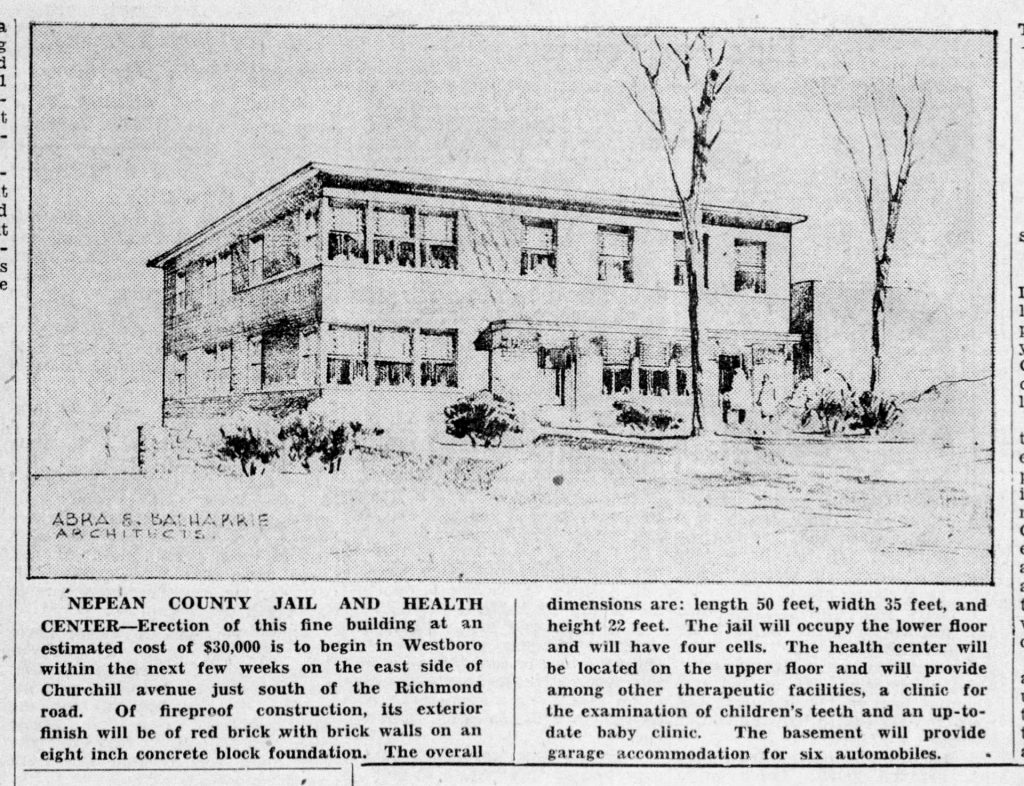
One local youth who visited the new jail, likely at that open house, was Ron Statham, who vividly remembers the trip 73 years later.
“I recall being with my father, and some others, having a tour of the jail. Reeve Keenan and a police officer showed us, with considerable pride, the actual steel bars, although I only remember two cells.”
The cells were located in the basement, on the north side of the building, with a small steel bar window, which still looks out over Elvis Lives Lane today.
Statham also remembered the station to be where Westboro citizens went to buy bicycle, car and gun licenses.
“The local police also controlled the village curfew for children, signified by the ringing town bell at 9 p.m. And, truly believe it, youngsters honoured and respected the curfew and if on the streets at 9 p.m. would run like the dickens home.”
The advantages of the station were numerous. The 24-hour presence of police deterred crime — juvenile delinquency decreased significantly, and having physical space outside of two small rooms at the town hall was a big plus. Constables no longer needed to take prisoners to the Nicholas Street jail at all hours of the night (the jail mainly functioned as a holding cell).
But the construction of the police station in Westboro may have been short-sighted. January 1950 saw Westboro annexed to the City of Ottawa. This posed an issue for Nepean Police, who had their barely three-year-old station now outside of the Township (the same problem with their town hall).
The result was the OPP oversaw Nepean for the next 14 years, while the Churchill Avenue station turned into a post office.
Meanwhile, officers from Westboro’s police station were absorbed into the Ottawa Police Department, at the Ottawa No. 2 station in Hintonburg at 7 Fairmont Ave. (now Forbes Beauty Company), the building which started life as Hintonburg’s original fire station. The No. 2 station policed the west end from Preston to the city limits near Bayshore.
In 1959, the Fairmont Avenue building was deemed too cramped for its staff of 60 policemen. An easy solution existed — a move back into the Churchill station, which was more spacious and still had the cell block and other facilities. Only minor renovation was required, as the police also took over the former health clinic. The doors reopened as a police station on Feb. 23, 1959.
Merv Baker was one of those officers who made the transfer with No. 2 from Fairmont to Churchill in 1959. He later worked alongside William Cathcart, whose son Kevin shared memories of their days in Westboro.
“What was interesting about the time was that only a few guys had cars. There were maybe five or six cars for the station, so most cops walked the beat. Some would get dropped off and take the bus,” Kevin shared.
Baker recalled a funny memory, that occasionally on the night beat they would take the “dog wagon” around (used during the day to catch stray dogs), when going to check the doors at Westgate or Carlingwood.
Mostly, Kevin notes that the Westboro station was focused on community and prevention. Often they would rely on the community to aid the small detachment.
In 1977, the station was slated for closure after the police commission recommended centralization of all staff and services into a new downtown headquarters. Churchill Avenue was the only sub-station left in Ottawa, which some officials referred to as “simply a wash-up place.” The Westboro BIA aggressively fought the closure, as did local residents, feeling the local station deterred crime. It was said that none of the four nearby Richmond Road banks ever had an armed robbery.
The police department argued that centralization would not affect efficiency or crime rates, and that the number of officers and cars patrolling the area would not change after the closure.
The new $22 million Elgin Street police headquarters opened on May 15, 1983. At 9:45 a.m. that day, the doors to the Churchill Avenue station were locked for the first time in 25 years. Rumour had it that there was a panic the week prior over whether a key even existed.
A year later the 5,400 square foot building was put up for sale, which has hosted a variety of office tenants since.
Today, Paterson & Company, an accounting firm, occupies the old police station, their front sign covering the old “Nepean Police” name chiselled into the front wall. Though a couple of old storage closets in the basement boast a more colourful history than their present appearance might convey, the nondescript building is a lasting legacy from Westboro’s true “village” days.
